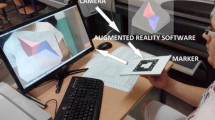Abstract
This paper describes a graphic application named Heighmap Examiner designed to help educate students on the computer graphics techniques that constitute the core of visualisation modules in GIS software. It applies various pixel-based algorithms over elevation datasets or heightmaps to obtain topographic and cartographic representations such as those made in professional software. The code is open and organised following this educational standpoint to let students understand and modify it if needed, even including new features to the application. This way, they can learn how modern topographical applications deal with terrain data under a computer graphics perspective to obtain contour maps, hypsometric maps, sunlight simulation, rain watersheds, etc., and also any combination of those. This paper describes the software’s overall organisation and the different algorithms applied to enhance performance and visual quality.
The application has been used as part of the MSc curriculum in Civil Engineering being taught at our university.
Access this chapter
Tax calculation will be finalised at checkout
Purchases are for personal use only
Similar content being viewed by others
References
Hutchinson, M.F., Gallant, J.C.: Representation of terrain. In: Geographical Information Systems, vol. 1, pp. 105–124. John Wiley & Sons, Inc., New York, NY (1999)
Kennelly, P.: The Geographic Information Science & Technology Body of Knowledge (2017). https://doi.org/10.22224/gistbok/2017.4.9. Accessed June 2021
Environmental Systems Research Institute, ESRI (1999). https://www.esri.com/en-us/arcgis/about-arcgis/overview. Accessed June 2021
Open Source Geospatial Foundation, QGIS (2009). https://qgis.org/en/site/. Accessed June 2021
gvSIG Association, gvSIG (2004). http://www.gvsig.org/en/web/guest/home. Accessed June 2021
Mapzen, Tangrams Heightmapper (2014). https://tangrams.github.io/heightmapper/. Accessed June 2021
Reas, C., Fry, B.: Processing: A Programming Handbook for Visual Designers and Artists. The MIT 412 Press, Cambridge, MA, USA (2014)
Fry, B., Reas, C.: Processing.org (2001). https://processing.org/. Accessed May 2021
Imhof, E.: Cartographic Relief Presentation, Redlands, CA. ESRI Press, USA (2007)
Ikeuchi, K.: Lambertian Reflectance, de Encyclopedia of Computer Vision, Springer, (2014)
Puertas, J., et al.: An augmented reality facility to run hybridphysical-numerical flood models. Water 12(3290) (2020)
Advanced Visualization and Cartography Group (VAC/videaLAB). https://videalab.udc.es. Accessed June 2021
Author information
Authors and Affiliations
Corresponding author
Editor information
Editors and Affiliations
Rights and permissions
Copyright information
© 2021 Springer Nature Switzerland AG
About this paper
Cite this paper
Hernández-Ibáñez, L.A., Barneche-Naya, V. (2021). Heightmap Examiner. A Descriptive Tool for Education in Digital Cartography. In: Stephanidis, C., et al. HCI International 2021 - Late Breaking Papers: Cognition, Inclusion, Learning, and Culture. HCII 2021. Lecture Notes in Computer Science(), vol 13096. Springer, Cham. https://doi.org/10.1007/978-3-030-90328-2_26
Download citation
DOI: https://doi.org/10.1007/978-3-030-90328-2_26
Published:
Publisher Name: Springer, Cham
Print ISBN: 978-3-030-90327-5
Online ISBN: 978-3-030-90328-2
eBook Packages: Computer ScienceComputer Science (R0)




